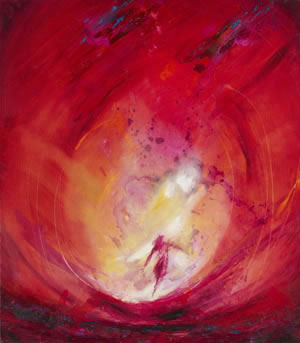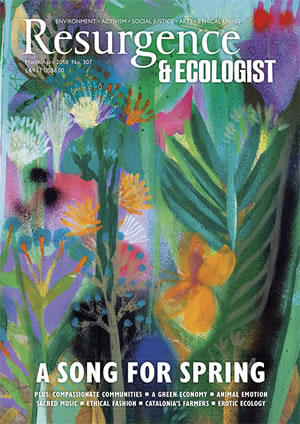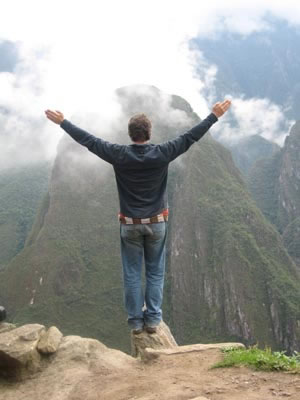Joseph Campbell was a mythologist and deep life explorer most famous for ‘The Hero’s Journey’ - his mythical template for storytelling which has been applied to numerous films, from Star Wars to The Matrix.
Campbell also taught how The Hero’s Journey - as a powerful map for transformation - can be usefully applied to our own lives.
In their biography on Campbell, A Fire in the Mind, Stephen Larsen and Robin Larsen report that, when asked in interviews how he found meaning in his life, Campbell would turn the question back, saying:
“If you want to ask me how I should live my life, I ask you, what is the most meaningful thing to you, your raison d’etre, and I suggest you ally yourself with that - your bliss.”
Campbell got a strong inkling of his own bliss from an early age. Growing up, he became a fascinated reader of books about Native American Indians, later writing in his journal that he was obsessed with “the figure of a naked American Indian with his ear to the ground, a bow and arrow in his hand, a look of special knowledge in his eyes.”
In A Fire in the Mind, the authors explain how Campbell followed “a kind of inner guidance, an apprenticeship to inner powers, to his own intuitions and premonitions.” And following this initial premonitory pulse, as a young man he went on to study and travel extensively, absorbing himself in the world of ideas, mythology, anthropology, art and religion, initially with aspirations to become a novelist. During a brief stint working in the family business, Campbell found the material world deadened his soul. Observing his fellow workers, he wrote in his journal, “They sacrifice their joy and adventures to money – and the money merely enables them more dull plodding – to bring more people into the world so that the same futile work and sorrow may be carried on for another span of years.” He decided to let go of money and do what he wanted.
Later he would say to his students: “Do you know what depression is? It’s when you have spent your life climbing up the corporate or whatever kind of ladder and you finally reach the top and find it’s against the wrong wall.”
It was while studying The Vedas, that the Sanskrit word Satchitananda, referring to the ultimate nature of reality in Hinduism, was to provide major inspiration for Campbell. Breaking the word down, he discovered that sat means ‘being’, chit ‘fully conscious’, and ananda ‘rapture’. “So Ananda is the only thing you can be aware of,” Campbell later explained in The Hero’s Journey documentary about his life and work. “Follow it, and it will all be alright. The probability is that everything will work out, even if you think it won’t.”
Campbell ultimately found his bliss as a mythologist, prolifically researching, writing and teaching about the mythic domain and its rich application for living a life imbued with meaning. His explorations led him on fascinating travels around the world, where he was particularly taken with the mythological and sacred landscapes of India and Japan. He wrote numerous books, and was a passionate and extremely popular teacher, most notably teaching mythology and literature at Sarah Lawrence College for 38 years. He was also highly in demand as a speaker and workshop leader around the world, and relished sharing his love and wisdom of mythology and the importance of awakening the mythic dimension in our own lives.
He was reported to be a man who was strikingly radiant and alive, until his death, aged 83, in 1987. George Lucas, and many others who knew him, would comment on the “life force” that poured out of him. So Joseph Campbell is a shining example for his own “follow your bliss” life philosophy.
However, later in his life, Campbell was sometimes criticised for the seemingly superficial nature of his “follow your bliss” mantra, his critics complaining that it encouraged people to be hedonistic or selfish. Such critics largely failed to understand the deeper context of his work. Campbell later said that what he should have said, was “follow your blisters”.
Exactly what Campbell meant by “follow your blisters” is open to interpretation. But as I understand it, he was essentially saying that when you truly follow your bliss, you will inevitably meet considerable challenges, but it’s through life’s challenges that we get to overcome our fears and grow. It’s not about having an easy ride, escaping, or sensory pleasures, for real bliss tends to be “hard-won”, all the greater for any endurances suffered along the way. And while you will likely have to work hard in pursuit of your bliss, it’s the love of the work which carries you through: think of activities you engage in where hours seem to fly by in minutes and you get clues to your bliss. And sometimes it’s the thing you can’t not do, your authentic path, however challenging that feels.
A major part of The Hero’s Journey is the “road of trials”: and on this road, the hero will face many hard knocks, even death, and get very lost and overwhelmed. The same can be said for taking a spiritual path – we need to be prepared that it’s not all about fast-tracking to love, light and inner peace – along the way you have to face your fears and any personal demons, and learn to accept unloved and unwanted parts of yourself, as well as releasing any old ineffectual ways and negative patterns. It’s about death and rebirth. The Hero’s Journey is a path of letting go, integration and renewal on the road to wholeness.
I first followed my bliss, aged 29, when I pursued a “Call to Adventure” (the first stage of a Hero’s Journey), leaving my PR job in London to go to India, intending to research and write a book and to explore a spiritual path. My life was falling apart around this time following the breakup of my marriage. I left for India with the foolhardy notion that by following my bliss I would return to London a year later, transformed and ready to begin my career as a writer. But a rocky road of trials lay ahead. Along the way I faced my fears and experienced a psychological breakdown that ultimately became a breakthrough: I found new strength, left the ‘London rat race’, and a more authentic and enlivening way of life opened up.

Painting: Follow Your Bliss by Louis Parsons
Following his bliss on his journey through mythology, arts, music and dance, as he fascinatingly explored the threads that connected them - Campbell was to discover that “unseen forces” seemed to support him on his quest, as if the universe somehow conspired to come to his aid. As he later famously said - if you follow your bliss, “the universe will open doors where before there were only walls.”
However, Campbell was lucky, he found a generous patron in the Bollinger Foundation who afforded him the capacity to pursue his passions, funding his many books and travels. Or was this luck?...Or merely that “doors opened” to him as a result of committing to his path of rapture?
From my own experience of following my bliss, I have found there have been times along the way, when doors really did open, and lots of synchronistic opportunities seemed to come my way, as if some magic was at play. Aged around 34, after the rocky period mentioned, I decided to commit myself to a purpose and set myself the intention to “inspire enlivened living” as a writer and holistic explorer, and to help “create a better world” in my wider PR and communications work which paid the bills.
Having committed myself to this decision, opportunities for holistic and travel journalism commissions in fascinating edge-of-the-world frontiers seemed to manifest magically and easily, and I secured fulfilling PR work for charitable and holistic organisations creating positive change. For a few years, my life flowed along happily, with an elated sense of following my dreams. By now I had discovered that my own rocky road to transformation mirrored the stages of Campbell’s Hero’s Journey, and was busy applying its structure to a book I was writing about that pivotal time of my life. While this book has taken a long time to manifest (currently being reinvented as a novel), the journey of writing it has sustained and captivated me. As the saying goes, “It’s the journey, not the destination”.
Like Campbell’s critics, I have occasionally questioned if there wasn’t an irresponsible edge to his “follow your bliss” message from a financial perspective. Campbell would tell his students not to worry about money, saying that if they followed their bliss, this was their security, and money would likely follow. Yet as mentioned, Campbell was fortunate in finding a patron. But for the many artists and writers he considered his target audience, there is no guarantee they will be so lucky, and the stakes can be high. So with this in mind, the Arab proverb “Trust in God but tie up your camel,” may be worth holding in balance. Follow your bliss, but take steps to preserve your financial security. And money of course buys more time and freedom to follow dreams. This is a conundrum that faces so many artistic and spiritually orientated people I know – how to follow your heart but also maintain a sustainable life? Perhaps another big challenge to grow through on the journey towards our bliss.
However, it is often fear which stops so many of us from following our bliss in the first place, starting with the fear of not having enough money. There may often be a strong case for overriding this fear and taking the leap of faith. People on their deathbeds looking back on their lives are said to regret not so much the risks they did take, but those things they never did.
Another major fear standing in the way of pursuing our passion, can be fear of what others think of us. Joseph Campbell said, “What they will think of me must be put aside for bliss”. Often we blame parents and others for holding us back, yet in reality it’s often our own fears and resistance that keeps us stuck.
As author Robin Sharma says in Finding Joe, an excellent documentary film about The Hero’s Journey: “What keeps you from the top of the mountain is your fear, your dragons.” And he recommends finding the courage to move forward in spite of the fear. “Courage is not lack of fear, it’s moving through it,” he says. “Do the thing that scares you.”
So when you take up the Call to Adventure and follow your bliss, you will have to face the dragon. But this is where the treasure lies. As Jung said, “The gold is in the dark”. And The Hero’s Journey is not just about following your bliss, but about finding something for yourself and then bringing that back in service to others in some way.
In Finding Joe, renowned skateboarding champion Tony Hawk explains how he “shared his treasure” by setting up a skate park for kids. Similarly, a writer featured in the documentary explains how he founded a writer’s fund to help other writers. For my part, having experienced the stages of the Hero’s Journey in my own life, I am now eager to share my experience of this transformative process to support others to move forward in their own lives. To this end, I will be co-facilitating a Hero’s Journey men’s weekend retreat in a magical 70-acre woodland near Salisbury in April, with natural happiness and resilience author Alan Heeks.
During the course of the weekend, we’ll be taking a group of men through the stages of The Hero’s Journey as a way to move towards a next big step in their lives, and supporting them to overcome any obstacles and fears that are likely to stand in the way. The retreat is essentially an invitation “to follow your bliss”. But participants should be prepared to get some blisters along the way!
For further info & bookings for The Hero’s Journey: Discover Yourself men’s retreat 20-22 April, see www.naturalhappiness.net/upcomingevents or contact Daniel Körner: [email protected] or 07599774716.








